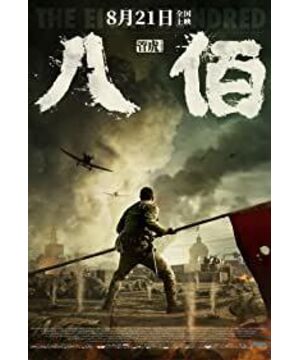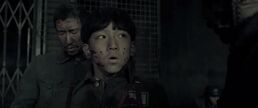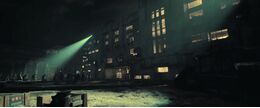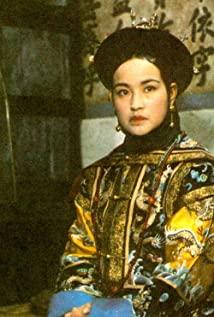In fact, isn't the reason for giving so much attention to "Eight Hundred" because of a feeling of anger in my heart: What the hell was filmed and not allowed to be released?
After it wasn't very easy to buy point screening tickets, I learned that the film was 13 minutes short of the original version that was supposed to be screened at the Shanghai Film Festival last year.
It wasn't until the film officially started, about 15 minutes later, that I figured out the first question. After watching the whole film, the second problem is solved. Because you can basically see which ones have been cut out ("1917" has cultivated everyone's ability to find editing points, which is all used in "Eight Hundred"). I can even understand that: it was deliberately made for everyone to see the deletion, and the effect of "silence is better than sound at this time" is not bad. As for what the answer is, I won't say, but can share a detail. The girl next to me spoke very loudly once while watching a movie. She said, "What kind of flag is that? Isn't it a wuxing red flag?"
I can give "Eight Hundred" a score of 7.5. If this film was released as scheduled, I should have given it a maximum of 7 points. However, the current situation this year, and the intertwining of various difficulties, it is really not easy for this film to finally be presented like this. So I'll add 0.5 extra points. I recommend it to everyone, men and women, young and old, war fans and non-war fans alike, especially for Pink. Since it's a mainland film, it doesn't involve grading. I don't think there are too many restricted-level pictures, and the lines are relatively obscure. The subtitles have been processed. It should be about PG13 for North America, but we still don't bring children who are too young.
I say five reasons why I recommend it:
1. The narrative of "group portrait" is neat and smooth. In fact, I seldom see domestic films that have done a particularly good job of group portraits, or that we have few group portraits in the first place. The only ones I can think of are "The Wind" and "The Death of Romantic". Although "The Sound of the Wind" also has a big background, due to the limitations of the location, each character's predicament is more from the villain; "Eight Hundred" builds a larger group portrait with deeper vertical and horizontal. There is no victory that depends on a character, a hero can be exchanged, not even a wolf. Big history is a baton-like transmission of little people who have no names to get to where they are today.
2. The character arc has a high degree of completion. If there are group portraits, there are characters. Sixty percent of the characters in the film have completed the character arc, and their degree of completion is relatively high - this is difficult to do in a group portrait scene with so many characters. At the same time, it is not easy to express the relationship between the characters. It can be seen that the director worked hard to create his own dilemma for each character. The combination of the situation dilemma and the self dilemma adds to the reality cruelty to the film. There are no perfect victims, and no perfect heroes, just flesh and blood.
3. The audio-visual language is remarkable. The audio-visual content of the film can be summed up in four words: Through the Looking Glass. "Mirror" is a glass window, a telescope, a camera lens, and a scope on a sniper rifle. The use of this "mirror" in the film has a very bright performance. It is my favorite place in this film. ;"Flower" corresponds to the animals in the film. This intention basically runs through the arc of one of the main characters. It's not natural to say otherwise, but you can always see a trace of romance in cruelty; "Water" is very simple, it is A very important geographical scene, which plays a role of separation and connection, the story takes place on this side and the other side of the water; by "moon" I mean the use of light. The film has been carefully lit, and there is no color correction. When you watch the film, you will notice that although the two sides of the river behave differently, the tone is the same. The night scenes with strong contrast between light and dark just illuminate the concession with neon lights, and the background colors are the same. This is of course designed to create the feeling that we are all in the same world, that we are all family.
4. The famous scene is deeply touching. The movie is famous for its scenes, and more than one. After the official release, it will definitely be widely discussed. Several girls in the first few rows sobbed for a long time because of this, while the boys searched for tissues in unison. Because my seat is relatively high, I can see their actions, and the time and frequency of their actions, so those scenes have already been reserved for this year's famous movie scenes. If there is a chance, we can also talk about these famous scenes in the spoiler section. I have a lot to say.
5. The theme content is precious and rare. After thinking about it for a while, I still want to talk about the theme... Although I have no way of knowing whether it was intentional at the beginning of the creation, or the result of the deletion at the later stage, the theme of this film is expressed with great restraint. There's nothing wrong with this restraint. There is no complete villain, no "hand tearing" ridiculous, no heartbreaking for no reason, no uninterrupted sound effects of "Dunkirk" and "1917", and no fearless halo protagonist with plug-ins. . Even the famous scenes are very restrained and stop when you click, making you lose your voice but still have room to think. This allowed me to see rare progress. I was shocked when I heard a few direct lines.
Of course, the film also has obvious shortcomings. The biggest flaw is in the structure. The original story timeline is very clear, but in the second half of the film, there is a strange confusion and separation. In addition, domestic films like to use the protagonist as a line in the film review, or the problem of typing the subtitles can't be corrected. This film is even more excessive. The subtitles with white characters on a black background can't wait to form a material.
I always believe that the one that asks you questions and asks you to find answers is a good movie, or that this is the attitude that a movie should convey to the audience.
The little characters in "Eight Hundred" and the baton in one hand seem to let me see "The Day When Dawn Comes".
"It's always difficult to do this kind of thing. But someone has to stand up and take a step."
Hope is the most annoying thing in the world.
View more about The Eight Hundred reviews











